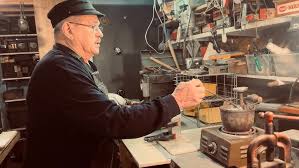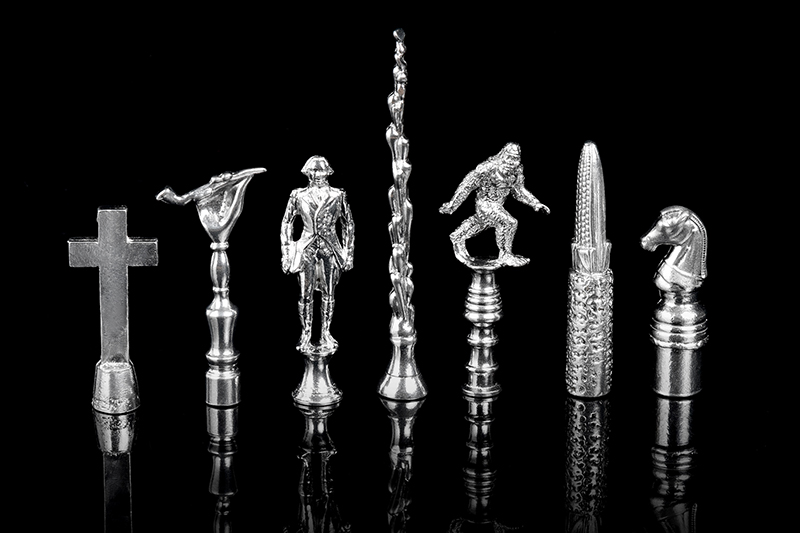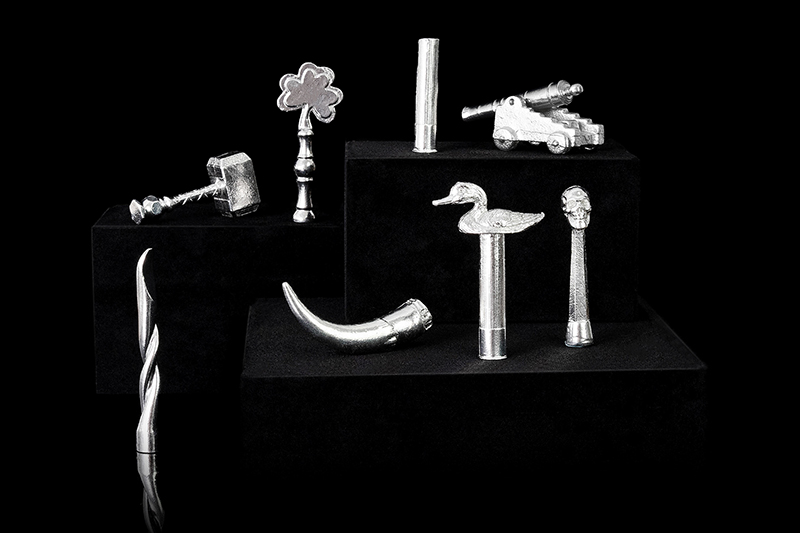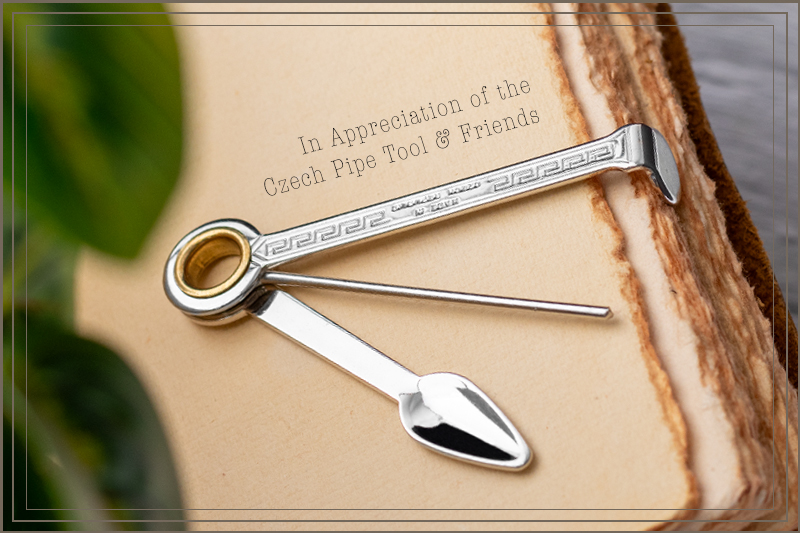The Magic of Pewter: Larry Blackett Pipe Tampers
We all need pipe tampers, except those tough enough to prefer a forefinger calloused by years of fire exposure. But most of us like an accessory for the purpose, and there are plenty to choose from. They can be as utilitarian as a wooden dowel or as luxurious as fine jewelry. They can cost nothing or thousands of dollars. Some, though, are as substantial, attractive, and luxurious as precious metals yet remarkably inexpensive — like Larry Blackett's tampers.
These tampers are made of pewter with a formulation developed by Larry himself. It possesses a unique silvery luster, which is contributed to by its sterling silver content. Larry has also crafted a considerable portfolio of shapes and themes and a remarkable finishing process. He's a sixth-generation building contractor capable of building houses from the ground up and has always been a do-it-yourself guy. When tampers became an interest, he instinctively picked up the craft. It came naturally to him after a long career of hands-on self-employment.

He had taken up jewelry-making as a hobby 40 years before making tampers. "I was setting diamonds, casting gold and silver, enameling, metal raising — it was never hard for me. I always understood exactly what I was doing." He was also a commercial photographer for nine years. "In 1967, I did over 95% of all the Chevy truck flat work, all of the direct mail pieces, the announcement catalogs, all of the stuff that was mailed to dealers and the like. I've done Cadillac and Lincoln Mercury." He studied commercial art in college and the photography fit his educational background.
"My son and I ran a business for 31 years as a father-and-son team, and I'm proud that we never had an argument. We were productive, and we had a fabulous reputation." Their business was in building the interiors of high-end retail stores. "We did over 50 Nordstrom stores and 14 Tiffany stores. We did the Louis Vuitton at the Bellagio and in West Palm Beach — seven altogether."
It was a rewarding profession, but when Larry had a stroke in 2022, he had to step away from the business. "When it happened, I was paralyzed," he says. "I could not move anything except my eyes. Finally, the feeling in my left side started returning, and I crawled to the living room and took my blood pressure, which was 278 over 160. By then, I could move again, and I drove myself to the hospital."
He lived with a meter in his chest and constant doctor visits for 14 months. "There was absolutely nothing wrong." He went through extensive blood tests and was found to be perfectly normal. "The best anybody could come up with was that it may have been a reaction to a booster shot."
With his primary business gone, Larry returned to crafts that he could do independently. Strangely, his tamper crafting grew from his 30-year interest in reenacting battles of the French and Indian War. "We reenacted from Nova Scotia all the way to Kansas City. I was the regimental sergeant major at Ticonderoga for their 250th celebration of the famous battle. I've been very successful as an organizer and in enlisting people to come on board and reenact. I do it for the love of history."
Reenactors are, of course, interested in acquiring and using authentic-looking gear, and it was a blow to the hobby when an essential supplier of buttons died. "He was the best in the industry. He made beautiful buttons, and I just got the idea that I'd like to maybe step in and fill the void. Not for income but just to fulfill the need for uniform buttons. Reenactors like to buy new uniforms for different personas. So there's always a market for uniforms and obviously for buttons, and buttons are expensive and they're hard to find. So I decided to make buttons that people could afford based on originals and as authentic as I could make them."
Larry did the work, developed formulas, and learned how to manufacture authentic buttons, calling his brand Buttons4yourbritches on Instagram. "I got my patterns together, started making buttons, and two weeks later, the coronavirus hit and the whole world stopped. Nobody was buying uniforms, nobody was buying buttons, and there were no reenactments. There was nothing."
... his tamper crafting grew from his 30-year interest in reenacting battles of the French and Indian War
Eric Kelley, better known on Instagram as Eric the Blue Collar Pipe Smoker, suggested that Larry make pipe tampers. "It sounded like a great idea, and I started with a 410 shell. Well, there was quite a lot of interest, and I kept going." The button business was still there and had a catchy name, so he kept it. Tampers became the primary product, but they're Buttons for your Britches tampers.
"We have tried to come up with new products and new ideas, and some of them have been fabulous successes and some of them have bombed something awful." Experimentation is necessary to find what people like, and Larry continues to experiment and find what works and is thematically and aesthetically attractive.
"I've developed a proprietary process of polishing pewter; no one else is doing it." That process makes his tampers gleam like silver and saves him enough manufacturing time to keep his prices reasonable, but because he developed it himself and wants to maintain the market advantage it affords, he doesn't share the details.
Tampers became the primary product
"There isn't anything I do that can't be copied with some insight and investigation. I've developed the process by incorporating things I did 40 years ago when I was studying jewelry, and I've adapted that and gotten advice from friends in the jewelry business, and have done a lot of correspondence and study about how to do this. By putting it all together, I've come up with something that's unique, and I want to keep it that way for as long as I can."
The Master Shapes
Larry's tampers start with a master shape to be reproduced in pewter, around which a mold will be made. Larry doesn't carve the originals, instead utilizing elements from figurines mostly unrelated to pipe tampers, though he has used components from a few antique tampers.
"I wish I were talented enough to carve the master shapes, but even if I could, the cost would be prohibitive. Hand-carved originals would push the cost of the tampers into the $100 range. We try to find an original subject and then modify it into a mold by attaching the base. The size of the base is important so that it'll stand up. We use the 3M copiers and pre-made subjects. We change the look of them; we modify them so that they will reproduce. I'm conscious of plagiarism. I really don't want to take somebody else's work, but I've never claimed that I am doing this as an art form. I'm doing this to reproduce clever, fun-looking subjects without infringing on Walt Disney or whoever else might have an interest in the product. We try to find things that are way out of any kind of legal ownership. These are not hand-carved, one-of-a-kind compositions. To get into that would be a completely different business."
Special Orders
Larry takes pride in producing unique and imaginative tampers, and he doesn't shy away from special assignments. He's reproduced tampers for different pipe clubs, for example. "That's always fun and challenging, and a lot of those are made from scratch."
When clubs contact Larry about a proprietary tamper, they work together on the design, and that tamper is available only to club members. "We did a toad shape recently for a group, which was pretty successful. And I reserved the design for them alone. I didn't make it available to the public. It was strictly something for their group."
A customer contacted Larry about having two special tampers made representing the Knights Templar for a Renaissance festival. "I made him a really clever, full-size knight in armor standing on the tamper base, and then I bought either an original or a reproduction of a Templar's coin, I'm not sure which it was, and went to the dollar store and found this little doll. I took the arm off of it, just the arm, and heated it up and bent it so that it looked like the Templar's coin was in its hand."
I'm doing this to reproduce clever, fun-looking subjects
That's an example of the way Larry develops designs. "Even though I didn't manufacture the hand or the coin, by putting the two together, I came up with a new concept, a creation of its own."
The All-Important Molds
The tampers are made by first pouring melted pewter into molds, and Larry makes all of his own molds. "I start with a concept. I rework it. If it's just a statue of Lincoln, I rework the legs, rework parts of it, and put a pedestal on it. Everything is made one at a time; there's no mass production."
Larry says that there are several types of molds for casting metals. "Mine is a gravity pour. I heat the pewter to the proper temperature — and some designs require it to be a little hotter so it's thinner when it's poured into the mold. There are also molds that are injection molds, which are done under pressure. With those, you can, in some cases, get a little more detail by forcing the product into the mold. Most typical is lost wax casting, where you carve the subject in wax, then put that in a plaster of paris holder mold, pour it, and then drop it in cold water when it's hot, and it blows all of the wax off." That process destroys the mold, so it can be used only once. It tends to be used with high-end jewelry and other items that aren't meant to be reproduced.
"There are a lot of cast products in car manufacturing, and I know that they have way more sophisticated systems than I do, but mine goes back to the original process from 4,000 years ago. They would use stone, making an original shape out of two pieces of stone and then pouring the metal into that. It's the original and oldest means of reproducing a particular item, going back to pre-Roman times."
Molds start in two pieces. "You make the first half; you pour that around your master figure and you let it harden, and then you pour the second half. That's typical of everything that's cast, from engines to jewelry. It's a process using a right and a left side; you put them together and pour the molten pewter into it, and after it sets up and has cooled, you open up the two halves, and you have the three-dimensional product. The problem is that in every mold, there are going to be defects. And as you use a mold, it starts to take on its own character. In some cases, it doesn't pour all the way. There are a lot of negatives." Larry says that about 20% of the pours are never used. Their pewter is remelted.
"There are technical aspects, too. You have to vent the molds, for example. And some molds don't work in halves. One of the molds I'm particularly proud of is the Washington's Pistol, which is in halves, but then there's the old-fashioned flintlock on the side. The mold itself had to be made in two parts with another part attached to it, which made it one-and-a-half on one side and three-quarters on the other."
It's been a learning process and every new piece has presented challenges. "I just finished a Marine Corps dress sergeant with his sword and hand swinging as he marches. So with that, I have elements going in two different directions, plus the body itself, so I had to mold the arm and sword separately. In some cases the subject matter is complicated and you have to experiment."
... mine goes back to the original process from 4,000 years ago
One particular figure has eluded him and he's still working out the details and figuring out the best approach. It's a John Deere tractor, and the problem is that it has many different complex components. "It's got four wheels and a steering wheel, and they all have to turn. It's got an engine compartment and a back seat. There are so many elements that when I make a mold, it locks itself in and I can't get it apart." He's decided that he'll have to mold each part separately and then permanently attach them. "So I've got it sitting there and I keep looking at it, but making a typical mold for that would be pretty hard." But he'll figure it out eventually.
Pewter
Pewter has been in use since the Bronze Age (3300-1200 BC). The oldest pewter found was in an Egyptian tomb dated 1450 BC. "Pewter in history has been a product for the rich. Since Colonial times, it's been approximately 97% tin and 1% antimony, which acts as a binding agent. Then the balance was traditionally either brass or copper, but I use sterling silver."
Up until 1947, lead was used in pewter, and that caused trouble, even death. Tomatoes were thought to be poisonous for hundreds of years. People became ill and often died after eating them but it turned out that the high acidity of tomatoes was leeching the lead from pewter tableware. It wasn't the tomatoes that were killing people; it was lead.
"I don't know why they thought they needed lead," says Larry. "Maybe as a binder, but lead is illegal in pewter now. So any fear of anyone getting any kind of lead poisoning or lead effects or whatever, that's all gone. It's illegal to use and is not a factor, but it gave pewter a bad name. The pewter of today is cleaner than your own dishes. It's a wonderful product with a great feel to it."
Larry's pewter has only three ingredients: tin, antimony, and sterling silver. The silver imbues it with a definitive luster and shine that manifests with Larry's finishing process. "Each piece is hand-finished. It goes through a 24-hour process, a combination of different types of polishing."
Polishing and Luster
It was primarily Larry's background in jewelry making that helped him develop his finishing processes. "Anything that is shiny, it doesn't matter if it's a diamond, it doesn't matter if it's your car, it doesn't matter what it is, the reason it is shiny is the lack of scratches. It's that simple. You get rid of the scratches and it automatically is going to be shiny no matter what it is. So even in wood, the finer you sand it, the shinier and smoother it will be." Larry's finishing process is simple enough: it concentrates on efficiently eliminating microscopic scratches.
A Blackett tamper will over time pick up wear and lose some of its shine. "Obviously, down the road, it's going to take on its own patina, which can look great on its own, and it's also going to take on scratches. Eventually, it needs to be polished, and you can use a regular jewelry polish to eliminate those scratches, and it'll shine again." Some people, though, like the patina.
"Pewter in history has been a product for the rich"
"I've started to use a patina process for some tampers. They're purposely darkened. I especially like that process for the tampers that represent people. The patina helps to highlight the detail: the eyes, the ears, the hands, all the different parts that if left just bright silver, you wouldn't see the detail as well. So I've been determining which ones I think should be polished and which ones shouldn't.
"... the reason it is shiny is the lack of scratches. It's that simple"
"They're all polished at first, and then the patina is applied. It's done with a chemical that I buy; it's not something I developed. Then I have another secret way where I burnish it to get a little bit of the shine back without taking away the black patina. So those are basically the two options available. The high gloss is almost shinier and brighter than sterling silver; it polishes just gorgeously. And then there are those that have the patina finish. Basically it's all stuff that I've worked out just through trial and error until I got what I liked and what I think the public likes."
Timelines
Although these tampers are individually made, Larry pours about 40 of them at a time. "The molds take two days to set up, to pour and let cure. What I'm trying to do now is pour five or six different shapes at a time so that I end up with about six to 10 of each pattern in a single pour. Then those go through 25-to-28 hours of different finishing processes."
Not counting the time necessary for making and preparing molds, a couple of days are invested. "That's if I stay right with it, no slacking. If I was to make just one and go through the whole process, it would take the same amount of time that it would take to make 40, other than the time of pouring them, because they all have to go through the same different steps."
Popularity
With more than 150 designs in his portfolio, Larry has a tamper for every taste. There's a universal affection for pewter. It looks great, can be fashioned into remarkable shapes, is interesting, beautiful, and provides a comforting weight in the hand.
"I think one of the bestsellers is an antique Sherlock Holmes. He's smoking a pipe, and that is appealing to a lot of people. Believe it or not, the Thor's Hammer is also very popular, which is strange. It's the most awkward, and it's heavy. There's no way you could carry it in your pocket comfortably."
"those go through 25-to-28 hours of different finishing processes"
The tampers are fun to display and available in a vast number of themes. Just as we choose a different pipe according to our mood, a different Blackett tamper can be chosen for any occasion. "I send tampers all over the world. I even had an order to send three of them to St. Petersburg, Russia, but the federal government wouldn't let me ship them. I just shipped out a tamper to Ireland. I just shipped out two tampers to Kuwait. I mean, people around the world are seeing my work."
Larry doesn't have a website, so he finds it beneficial to have his work at Smokingpipes. "I think people from around the world now know my work thanks to Smokingpipes." Part of the attraction is the inherent value of these pieces. They provide a lot of satisfaction for the price, and Larry resists the inflation that has dominated virtually every product in recent years.
"I maintained my prices on my original pieces when the inflation started to boil. To this day, I am still selling the first stuff that I made for the same price. I've brought the price up a little for newer tampers, mainly because raw materials are more expensive. I've compensated a little bit. My typical $16 tamper is now $18 or so." His tampers range from $18 up to $40+, depending on their complexity and weight. "I just want to provide a good product at a price that the average guy can afford."
"I send tampers all over the world"
The important thing for Larry is to get his work into the hands of everyday pipe smokers. "I have to admit that I have an ego. I don't want anyone to ever be able to find tampers of equal quality. I don't want mine to be uninteresting. I want them to be collectible and appreciated. Pewter can last thousands of years. It's not going anywhere. It doesn't deteriorate. If you don't abuse it, it'll stay exactly like it is. I want for people to someday say, 'My grandpa passed this tamper on to me,' or, 'Larry Blackett made this tamper and my dad used it for decades.'"
Blackett tampers certainly have what it takes to be heirloom pieces for future generations. They're fun, with loads of personality, and are handsomely finished, worthy of the pride in ownership and satisfaction they provide. We all have to tamp our tobaccos. Why not do it in style.















Comments
Beautiful and excellent craftsmanship Mr. Blackett! I wish someone with your mindset was crafting tin soldiers. Unfinished tin soldiers that can be painted. I wanted to paint some to reflect the service of ancestors of mine and was astounded at how expensive they are and uninteresting many were as well. Maybe you could branch out? 😃
The craftsmanship is simply stunning, Mr. Blackett! I wish someone with your level of skill and attention to detail was making tin soldiers—especially unfinished ones that could be painted. I've been wanting to customize some to honor the service of my ancestors, but I was surprised by how expensive and uninspiring many of the options are.